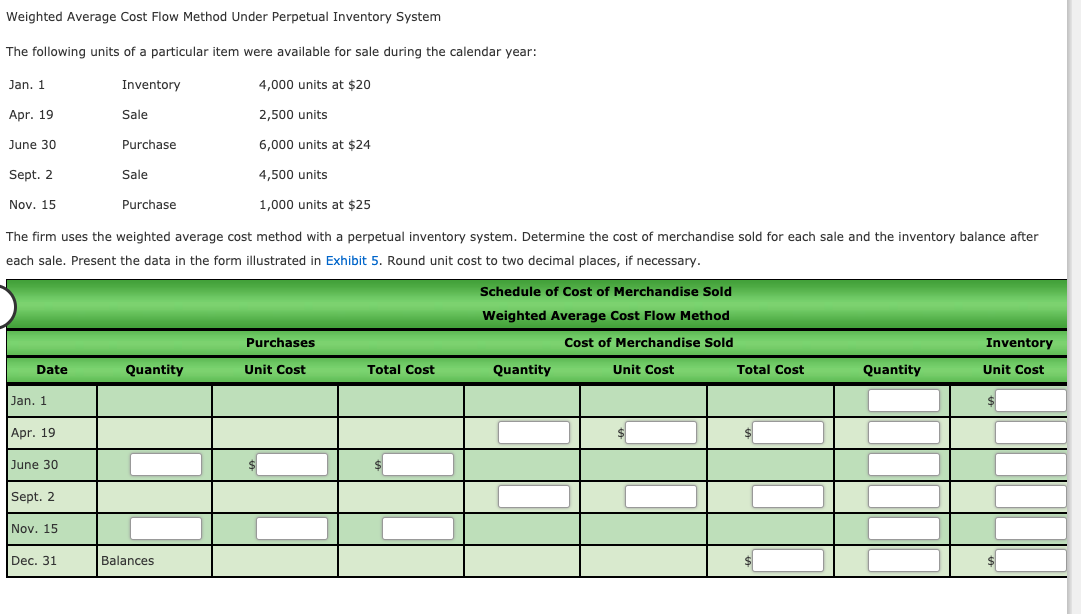Weighted Average Cost Flow Method Under Perpetual Inventory System The following units of a particular item were available for sale during the calendar year: Jan. 1 Inventory 4,000 units at $20 Apr. 19 Sale 2,500 units June 30 Purchase 6,000 units at $24 Sept. 2 Sale 4,500 units Nov. 15 Purchase 1,000 units at $25 The firm uses the weighted average cost method with a perpetual inventory system. Determine the cost of merchandise sold for each sale and the inventory balance after each sale. Present the data in the form illustrated in Exhibit 5. Round unit cost to two decimal places, if necessary. Schedule of Cost of Merchandise Sold Weighted Average Cost Flow Method Purchases Cost of Merchandise Sold Inventory Date Quantity Unit Cost Total Cost Quantity Unit Cost Total Cost Quantity Unit Cost Jan. 1 Apr. 19 June 30 Sept. 2 Nov. 15 Dec. 31 Balances
Weighted Average Cost Flow Method Under Perpetual Inventory System The following units of a particular item were available for sale during the calendar year: Jan. 1 Inventory 4,000 units at $20 Apr. 19 Sale 2,500 units June 30 Purchase 6,000 units at $24 Sept. 2 Sale 4,500 units Nov. 15 Purchase 1,000 units at $25 The firm uses the weighted average cost method with a perpetual inventory system. Determine the cost of merchandise sold for each sale and the inventory balance after each sale. Present the data in the form illustrated in Exhibit 5. Round unit cost to two decimal places, if necessary. Schedule of Cost of Merchandise Sold Weighted Average Cost Flow Method Purchases Cost of Merchandise Sold Inventory Date Quantity Unit Cost Total Cost Quantity Unit Cost Total Cost Quantity Unit Cost Jan. 1 Apr. 19 June 30 Sept. 2 Nov. 15 Dec. 31 Balances
Financial And Managerial Accounting
15th Edition
ISBN:9781337902663
Author:WARREN, Carl S.
Publisher:WARREN, Carl S.
Chapter6: Inventories
Section: Chapter Questions
Problem 2PB: LIFO perpetual inventory The beginning inventory for Dunne Co. and data on purchases and sales for a...
Related questions
Question

Transcribed Image Text:Weighted Average Cost Flow Method Under Perpetual Inventory System
The following units of a particular item were available for sale during the calendar year:
Jan. 1
Inventory
4,000 units at $20
Apr. 19
Sale
2,500 units
June 30
Purchase
6,000 units at $24
Sept. 2
Sale
4,500 units
Nov. 15
Purchase
1,000 units at $25
The firm uses the weighted average cost method with a perpetual inventory system. Determine the cost of merchandise sold for each sale and the inventory balance after
each sale. Present the data in the form illustrated in Exhibit 5. Round unit cost to two decimal places, if necessary.
Schedule of Cost of Merchandise Sold
Weighted Average Cost Flow Method
Purchases
Cost of Merchandise Sold
Inventory
Date
Quantity
Unit Cost
Total Cost
Quantity
Unit Cost
Total Cost
Quantity
Unit Cost
Jan. 1
Apr. 19
June 30
Sept. 2
Nov. 15
Dec. 31
Balances
Expert Solution
This question has been solved!
Explore an expertly crafted, step-by-step solution for a thorough understanding of key concepts.
This is a popular solution!
Trending now
This is a popular solution!
Step by step
Solved in 3 steps with 1 images

Recommended textbooks for you

Financial And Managerial Accounting
Accounting
ISBN:
9781337902663
Author:
WARREN, Carl S.
Publisher:
Cengage Learning,

Cornerstones of Financial Accounting
Accounting
ISBN:
9781337690881
Author:
Jay Rich, Jeff Jones
Publisher:
Cengage Learning

Financial Accounting: The Impact on Decision Make…
Accounting
ISBN:
9781305654174
Author:
Gary A. Porter, Curtis L. Norton
Publisher:
Cengage Learning

Financial And Managerial Accounting
Accounting
ISBN:
9781337902663
Author:
WARREN, Carl S.
Publisher:
Cengage Learning,

Cornerstones of Financial Accounting
Accounting
ISBN:
9781337690881
Author:
Jay Rich, Jeff Jones
Publisher:
Cengage Learning

Financial Accounting: The Impact on Decision Make…
Accounting
ISBN:
9781305654174
Author:
Gary A. Porter, Curtis L. Norton
Publisher:
Cengage Learning

College Accounting, Chapters 1-27
Accounting
ISBN:
9781337794756
Author:
HEINTZ, James A.
Publisher:
Cengage Learning,

Survey of Accounting (Accounting I)
Accounting
ISBN:
9781305961883
Author:
Carl Warren
Publisher:
Cengage Learning

Intermediate Accounting: Reporting And Analysis
Accounting
ISBN:
9781337788281
Author:
James M. Wahlen, Jefferson P. Jones, Donald Pagach
Publisher:
Cengage Learning